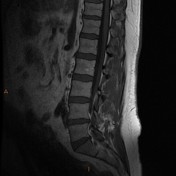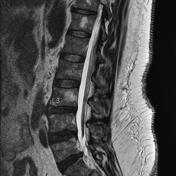Search results for “( "Chronic Inflammatory Demyelinating Polyneuropathy" )”
Did you mean
chronic inflammatory polyneuropathy?
22 results found
Article
Chronic inflammatory demyelinating polyneuropathy
Chronic inflammatory demyelinating polyneuropathy (CIDP) is an acquired demyelinating disease involving peripheral nerves, and is generally considered the chronic counterpart to Guillain-Barré syndrome (GBS).
Clinical presentation
Patients typically present with a gradual and protracted (>2 m...
Case
Chronic inflammatory demyelinating polyneuropathy

Published
30 Dec 2014
80% complete
MRI
Case
Chronic inflammatory demyelinating polyneuropathy (CIDP)

Published
22 Mar 2020
77% complete
MRI
Case
Chronic inflammatory demyelinating polyneuropathy (CIDP)

Published
29 Dec 2010
53% complete
MRI
Article
Medical abbreviations and acronyms (C)
This article contains a list of commonly used medical abbreviations and acronyms that start with the letter C and may be encountered in medicine and radiology (please keep both the main list and any sublists in alphabetic order).
A - B - C - D - E - F - G - H - I - J - K - L - M - N - O - P - Q...
Article
Onion bulb formation
Onion bulb formation is a histopathologic finding in hypertrophic neuropathies such as Charcot-Marie-Tooth type 1A (CMT1A) and chronic inflammatory demyelinating polyneuropathy (CIDP).
Pathology
Onion bulb formations are concentric layers of Schwann cell processes and collagen surrounding axon...
Article
Guillain-Barré syndrome
Guillain-Barré syndrome (GBS) is a heterogeneous group of autoimmune polyradiculopathies, involving sensory, motor, and autonomic nerves. It is the most common cause of rapidly progressive flaccid paralysis. It is believed to be one of a number of related conditions, sharing a similar underlying...
Article
Camptocormia
Camptocormia, also known as bent spine syndrome or cyphose hystérique, is a rare syndrome characterized by involuntary flexion of the thoracolumbar spine with weight-bearing which reduces when lying down, and is due to isolated atrophy of the paraspinal muscles.
Epidemiology
In a small case se...
Article
Multiple cranial nerve thickening and enhancement
The most common causes of multiple cranial nerve thickening and enhancement include:
metastasis (most common)
neurofibromatosis type II
lymphoma and leukemia
multiple sclerosis
chronic inflammatory demyelinating polyneuropathy
Lyme disease
See also
cranial nerve enhancement: for comple...
Article
Cranial nerve enhancement
Enhancement of cranial nerves has a lengthy differential including 1-2:
infection
mycobacterial: tuberculosis, leprosy
bacterial: mycoplasma
spirochetes: Lyme disease, syphilis
viruses: e.g. herpes zoster virus, influenza virus, human herpesvirus 1 (HHV1) 3
funguses
parasites
granulomato...
Article
Nerve compression syndrome
Nerve compression syndromes or nerve entrapment neuropathies are a group of several nerve disorders associated with sensory and/or motor loss resulting from nerve compression.
Epidemiology
Nerve compression syndromes are common 1-5 and can account for 10-20% of cases in specialist clinics of n...
Article
Nerve root enhancement
Nerve root enhancement is a phenomenon described on post-contrast MRI scans that can be observed in a number of situations.
Common causes
post-operative nerve root enhancement 6
arachnoiditis
leptomeningeal metastases
disseminated spinal leptomeningeal metastases
neurolymphomatosis
HIV va...
Article
Brachial plexitis
Brachial plexitis refers to inflammatory change involving the brachial plexus. This is in contrast to a brachial plexopathy meaning any form of pathology involving the brachial plexus.
Epidemiology
Brachial plexitis is more commonly seen in men between 30 and 70 years of age and is bilateral i...
Article
Transthyretin amyloidosis
Transthyretin (ATTR) amyloidosis is a form of systemic amyloidosis characterized by the misfolding, aggregation and deposition of transthyretin-related (TTR) protein in various organs 1-6. This can occur in the following two forms namely in the setting of a genetically normal transthyretin-relat...
Article
Central nervous system curriculum
The central nervous system curriculum is one of our curriculum articles and aims to be a collection of articles that represent the core central nervous system knowledge.
Definition
Topics pertaining to the intracranial content (brain, pituitary, dura, intracranial vasculatures). There will be...
Article
Vegetable and plant inspired signs
There are many signs in radiology which are vegetable- and plant-inspired, they include:
Unprocessed produce
bamboo spine
bright tree appearance
celery stalk (disambiguation):
celery stalk sign anterior cruciate ligament
celery stalk metaphysis
Christmas tree intestinal atresia
coconut l...
Article
Onion sign (disambiguation)
Due to its distinctive morphology and its layered internal structure the onion has given rise to a number of signs in imaging:
onion bulb appearance: Baló concentric sclerosis
onion bulb nerves: Charcot-Marie-Tooth type 1A and chronic inflammatory demyelinating polyneuropathies (CIDP)
onion ...
Article
Demyelination
Demyelination is incorrectly often equated to multiple sclerosis, whereas in reality it is a generic pathological term simply describing, as the word suggests, the loss of normal myelin around axons in the central nervous system. This should be distinguished from dysmyelination where the formati...
Article
POEMS syndrome
POEMS syndrome is the acronymic name for a rare multisystem paraneoplastic disorder including the following features:
P: polyneuropathy
O: organomegaly
E: endocrinopathy
M: monoclonal gammopathy
S: skin changes
Clinical presentation
The diagnostic criteria differ from the acronym. Accordi...
Article
VEXAS syndrome
VEXAS (vacuoles, E1 enzyme, X-linked, autoinflammatory, somatic) syndrome is a severe, treatment-refractory, monogenic, multiorgan, autoinflammatory condition with vasculitic and hematological complications.
Epidemiology
VEXAS syndrome is likely to be rare, but also likely to be underdiagnosed...









 Unable to process the form. Check for errors and try again.
Unable to process the form. Check for errors and try again.